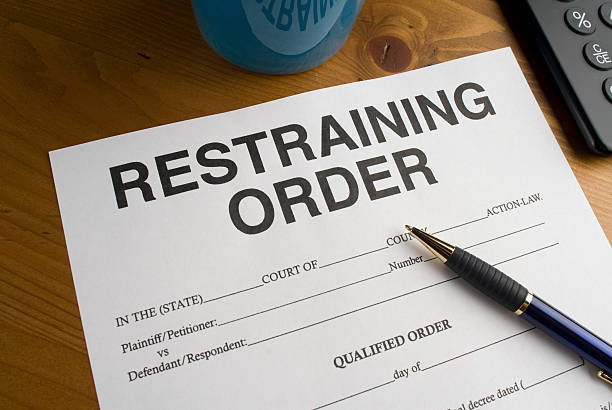If you’ve just been served with a restraining order against me, it’s normal to feel overwhelmed or confused. A restraining order, also known as a protective order, is a legal order issued by a court to protect someone from abuse, threats, stalking, or harassment. These orders can significantly limit your actions, including where you can go, who you can contact, and even whether you can stay in your home.
It’s important to understand that a restraining order is a serious legal matter. Violating one intentionally or not can lead to arrest, criminal charges, and other long-term consequences. This blog will walk you through the steps you should take right away and help you understand your options under California law.
Immediate Actions Upon Receiving a Restraining Order
Stay Calm and Do Not Resist Service
When you are served with a restraining order, it is critical to remain cool. Do not fight with the process server or attempt to refuse the paperwork. Accept the documents quietly. Getting angry or defensive in this moment could be used against you later.
Read the Documents Carefully and Understand Them
Go through every page of the restraining order. Pay close attention to:
- The type of restraining order issued (temporary or permanent)
- The name of the protected person
- Restrictions about places you cannot go (like their home, school, or workplace)
- A court date and location for your hearing
Understanding these details will help you avoid unintentional violations.
Do Not Contact the Protected Person
No matter how you feel about the situation, do not reach out to the protected person. That includes phone calls, texts, emails, or contact through friends, family, or social media. Even if the allegations are false, reaching out could land you in legal trouble.
Document Everything
Keep copies of the restraining order and any related documents in a safe place. Start keeping a log of any events that may be important for your case, including your own movements or people you spoke with.
Different Types of Restraining Orders to Know
Temporary Restraining Order (TRO)
A TRO is a short-term order to provide immediate safety. It’s often issued without your presence in court. TROs typically last until the court date, when both parties will have a chance to tell their side.
Permanent Restraining Order
This is issued after a court hearing. There are different types:
- Domestic Violence Restraining Orders – Between people in close relationships
- Civil Harassment Restraining Orders – For neighbors, roommates, or acquaintances
- Workplace Violence Restraining Orders – Usually filed by employers
- Elder or Dependent Adult Abuse Restraining Orders – To protect vulnerable individuals
Each type comes with specific rules, but all are legally binding.
Seeking Legal Counsel Immediately
Why You Should Talk to a Lawyer
California’s laws around restraining orders can be complicated. A lawyer who handles these matters can help explain what you’re facing and how best to respond.
Benefits of Having a Lawyer
- Clarify your legal rights and responsibilities
- Build a strategy for your court hearing
- Help you gather the right documents and witnesses
- Present your case in the best way possible
- Make sure procedures are properly followed
How to Find a Lawyer
You can search through:
- The State Bar of California’s referral service
- Local legal aid organizations
- Recommendations from family or friends
Act quickly. The earlier you get legal advice, the better prepared you’ll be.
Preparing for the Restraining Order Hearing
Work Closely with Your Lawyer
Be honest about your side of the story. Share any relevant documents like text messages or emails. Your lawyer may also suggest calling witnesses who can support your version of events.
Understand the Court Process
A judge will listen to testimony, ask questions, and review evidence. Stay calm, dress appropriately, and follow all court instructions.
Possible Outcomes
After the hearing, the judge may:
- Dismiss the restraining order completely
- Extend the temporary order
- Grant a permanent restraining order
The outcome depends on the evidence and how each side presents their case.
Consequences of Violating a Restraining Order in California
Criminal Charges
Violating a restraining order is a crime. In many cases, it’s a misdemeanor, but if violence or repeat offenses are involved, it can be charged as a felony. Punishment can include jail time, fines, and probation.
No Excuse for Violation
Saying you didn’t understand the order or thought it was unfair won’t help in court. Courts expect you to follow the order exactly, regardless of how you feel about it.
Strict Compliance is Key
Only a judge can change or cancel the order. Following the order exactly is your best way to avoid further legal problems.
What to Do If You Believe the Restraining Order Was Wrongfully Issued
Follow the Order Anyway
Even if the accusations are false or you feel wronged, follow the order until a judge changes it. Ignoring it could lead to criminal charges and hurt your credibility.
Challenge the Order in Court
Your lawyer can help file a motion to change or dismiss the restraining order. You’ll need to gather strong evidence to show the order was unnecessary or based on false claims.
Conclusion
Having a restraining order against me is a serious situation that requires a careful and calm response. From the moment you’re served, every action you take can affect the outcome of your case. Read the documents closely, avoid all contact with the protected person, and get legal help right away. Preparing well for the hearing and following the court’s instructions can make a significant difference in the result.
Get in touch with the legal team at The Nieves Law Firm for more information. By staying informed and acting responsibly, you can handle the situation with clarity and reduce the chances of long-term legal problems.
